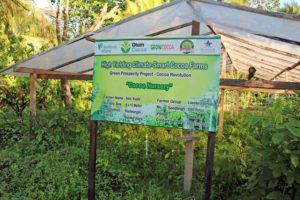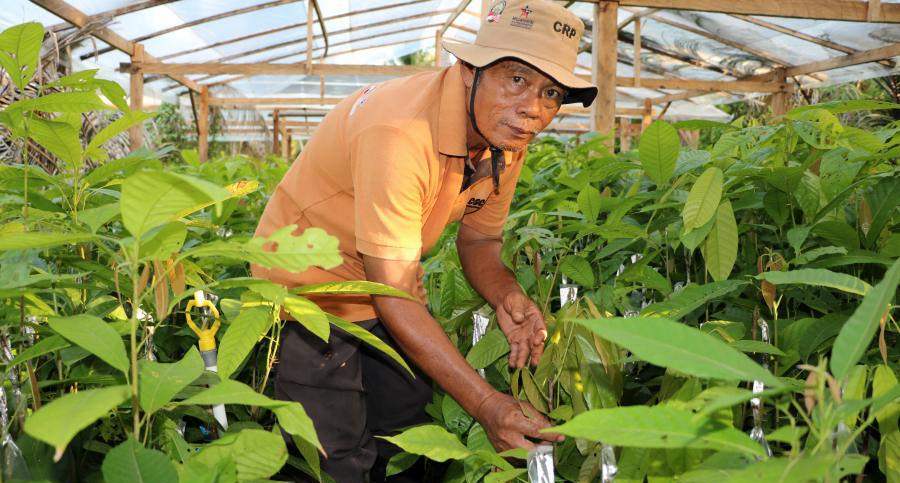On the island of Sulawesi in Indonesia, Abdul “Pak” Kadir (pictured above) has farmed cocoa (cacao) for over three decades.
But this 53-year-old is not one to rest on his laurels (nor his cocoa pods). With global demand soaring—but local productivity faltering—this community leader jumped at the chance to attend Rainforest Alliance training sessions that helped him make his business more profitable and climate resilient. In the process, he helped restore the local ecology and revitalize the local economy.
Pak Abdul is one of around 8,000 cocoa farmers who have benefitted from the Rainforest Alliance’s Cocoa Revolution project on Sulawesi. Co-funded by the United States through Millennium Challenge Account—Indonesia (MCA-Indonesia), the project supports the Rainforest Alliance and its private sector partners P.T. Olam Indonesia and GrowCocoa in efforts to address climate change and rural economic revitalization.
As leader of his local farm group, Lawekara Bersatu, Pak Abdul knows that his colleagues worry about their trees’ declining productivity and increasing climate-related diseases. One thing he learned in trainings was how to rejuvenate aging trees by grafting new scion onto old rootstocks.
 Armed with this knowledge—along with many other insights aimed at improving incomes while reducing greenhouse emissions and increasing carbon stocks—Pak Abdul started a cocoa tree seedling nursery that cultivates climate change- and disease-resistant strains. “I learned how to run my own nursery in the trainings,” he said.
Armed with this knowledge—along with many other insights aimed at improving incomes while reducing greenhouse emissions and increasing carbon stocks—Pak Abdul started a cocoa tree seedling nursery that cultivates climate change- and disease-resistant strains. “I learned how to run my own nursery in the trainings,” he said.
Since there’s a dearth of such seedling nurseries in his area, Pak Abdul knew his new business would be successful—and that it would help his colleagues, who until now have had little access to affordable seedings. “It is only natural that I would be successful, and that makes my neighbors more successful, too,” he said.
Since Pak Abdul started his nursery in 2016, demand has increased so much that he’s already expanded from one 150-square-meter shade house to four. Each shade house can accommodate up to 10,000 trees at a time—enough to rejuvenate 25 hectares of cocoa. The nurseries provide a steady source of seedlings to members at affordable prices, using a financing strategy to help spread the costs over time.
Gazing out at the patchwork of farms and forested mountains that can be seen from his nursery, Pak Abdul speaks passionately about the need for more seedlings and better land management in his area.
With Rainforest Alliance-supported trainings and technical assistance, Pak Abdul’s wish is closer to being fulfilled: participating farmers now manage their soil better, plant shade trees to restore wildlife habitat and protect against climate change-related weather events. They also plant companion trees that house native ants that protect to cacao tress from insect pests.
Such efforts lay the groundwork for greater economic and ecological stability. With more markets demanding—and willing to pay for—cocoa that is sustainably produced, and more farmers committed to protecting upland forests, the future is brighter for Pak Abdul and his friends in Lawekara Bersatu.
Photos courtesy of Rainforest Alliance.
This article originally appeared here on the Rainforest Alliance website. Reprinted with permission.

